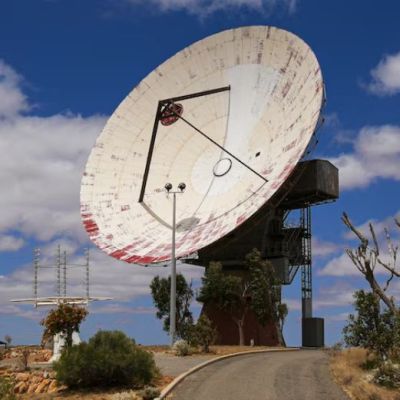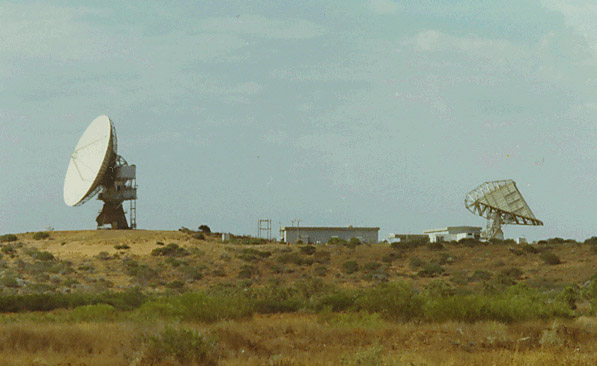
Recently the 29.8 meter parabolic antenna at the Australian OTC (overseas telecommunications commission) station came back to life again after nearly forty years spent in decommissioning limbo.
This parabolic dish antenna shares an illustrious history together with the older 12.8 meter Casshorn antenna in that together they assisted with many NASA missions over the decades. These not only include the Apollo 11 Moon landing with the small antenna, but joined by the larger parabolic dish (in 1969) the station performed tracking duty for NASA, ESA and many other missions. Yet in 1987 the station was decommissioned, with scrapping mostly averted due to the site being designated a heritage site, with a local museum.
Then in 2022 the 29.8 meter parabolic dish antenna was purchased by by ThothX Australia, who together with the rest of ThothX’s world-wide presence will be integrating this latest addition into a satellite tracking system that seems to have the interest of various (military, sigh) clients.
Putting this decommissioned dish back into service wasn’t simply a matter of flipping a few switches. Having sat mostly neglected for decades it requires extensive refurbishing, but this most recent milestone demonstrates that the dish is capable of locking onto a satellites. This opens the way for a top-to-bottom refurbishment, the installation of new equipment and also a lick of paint on the dish itself, a process that will still take many years but beats watching such a historic landmark rust away by many lightyears.
Featured image: OTC Earth Station. (Credit: Paul Dench)
















So, uh… Not sure if this is a Freudian slip or not, but it’s not ThotX, but ThothX… That first one will likely lead to some interesting search results.
Very honest typo, thanks for mentioning it. I’ll take your word for it that I do not want to google the typo-ed version, as I have no connotation what either spelling means :)
Well, one is the Egyptian god of wisdom. The other …
Sincerely, as a telecommunications satellite specialist working for an Offshore company I think there’s anything behind this because such antenna is a scrap. A mount of rust! Repairing this would cost more than building a new one much better and with new features! It doesn’t make sense!
Perhaps I just like big old antennas or something but I don’t totally agree with your conclusion. For higher frequencies you’d likely be better off buying new, but it would be ok for S band as is or even X band with a bit of effort. Mostly I’m wondering where you’d find the budget to build a modern steerable 29m antenna?
By by?
Buh-bye!
The best part of the linked article is the gif of the CEO crawling through a pipe vacuuming up debris by hand.
I love the calibration sticker on the spectrum analyser is from 2017! Ain’t no blank cheques being waved around there!
How to treat a World Heritage site, Australian style: smash all the historical telecommunications equipment, and bury it in a ditch. Sell-off that was too big to dismember. It wasn’t in very good shape when I passed-though a decade ago. Those that originally staffed the facility appear to have enjoyed their time. Awesome (yet now decrepit) swimming pool with very sexy poolside cabana units. Former greatness, now just a post-apocalyptic ruin.
Of all sites, I would’ve expected Hackaday to know that the lightyear is a measure of DISTANCE, not time!
But is it bigger than a country mile?
The phrase is using it as a unit of distance, in an idiomatic way. See: https://idioms.thefreedictionary.com/win+by+a+mile
I thought it was a tongue in cheek reference to the well known cringy line in Star Trek TOS..
“If I have to stay here for 10 light-years, I will not be soiled with any contact with you.” – Elaan of Troyius
I find it almost weird that something like this would get decommissioned & scrapped – surely once it’s not useful for its original purpose there’d be some group keen to pick it up for above scrap value and use it for something?
Your didn’t read it all 🤦♂️
Sort of like these Colorado hams?
https://dses.science/
Oh interesting – I didn’t know there was a Carnarvon in Australia as well, and about its long history with the NASA missions! Strange that the South African component of the Square Kilometer Array is built near another Carnarvon, in Meerkat National Park. My first though was that “Australia” was a typo in the article’s title. Thanks for sharing!
https://en.wikipedia.org/wiki/Square_Kilometre_Array
https://en.wikipedia.org/wiki/Carnarvon,_South_Africa#:~:text=Square%20Kilometre%20Array
Are you talking about Caernarvonshire in Wales? Some members of the Manx branch of my grandfather’s family went there from the island to marry in the 1800’s. I guess they were trying to avoid the small gene pool on Isle of Man! Smart, actually.😏
I got all excited for a few seconds and thought someone had used the Anglicised name for a city in North Wales and that there was a great big satellite tracking dish and a square Kilometre array only 90 miles away from me.
I’ll have to make do with Jodrell Bank instead.
I thought exactly the same: that isn’t how you spell Caernarfon!
And Goonhilly down in Cornwall
A great part of Space exploration history..visited it as part of a local guided tour on my travels back packing up the West Coast in 1990..well worth preserving.
Light years is not a measure of time.
https://hackaday.com/2025/01/12/carnarvons-decommissioned-nasa-satellite-dish-back-in-service-after-40-years/#comment-8082585
parabolic, or Cassegrain?
looks like neither (well they all parabolic)… its actually Gregorian! …Cassegrain uses a convex reflector…this is definitely concave, which makes it gregorian..
Huh? In the last image in the article, you can clearly see that the secondary’s convex. Most radio telescopes are Cassegrains or variants.
Rust? That looks like arid climate. Red lead primer showing through the sun worn paint. Probably a lot better than if in Florida.
I thought the same; will their be rust? Sure, but it will be mostly be surface rust.
I enjoy complaining about obsolete satellite dishes. Complaining about obsolete satellite dishes is cool. Bow ties are cool. Fezzes are cool.
I enjoy reading the Hackaday posts. Even though I don’t comprehend most all of it. Too old now to learn enough to know what it all means, but it sounds good.
“seems to have the interest of various (military, sigh) ”
I can’t imagine Australia as the aggressor. But it’s nice for one’s country to have a built up military so long as someone else IS out there looking for who they can take from. cough cough Russia
Reminds me of that movie called “The Dish”, about an Australian NASA tracking station. “You tell NASA you lost the spacecraft”… Excellent movie..
In Switzerland they use these discs in another way:
https://sonnenallee.sma.de/en/solar-energy/giving-old-satellite-dishes-a-new-lease-on-life/